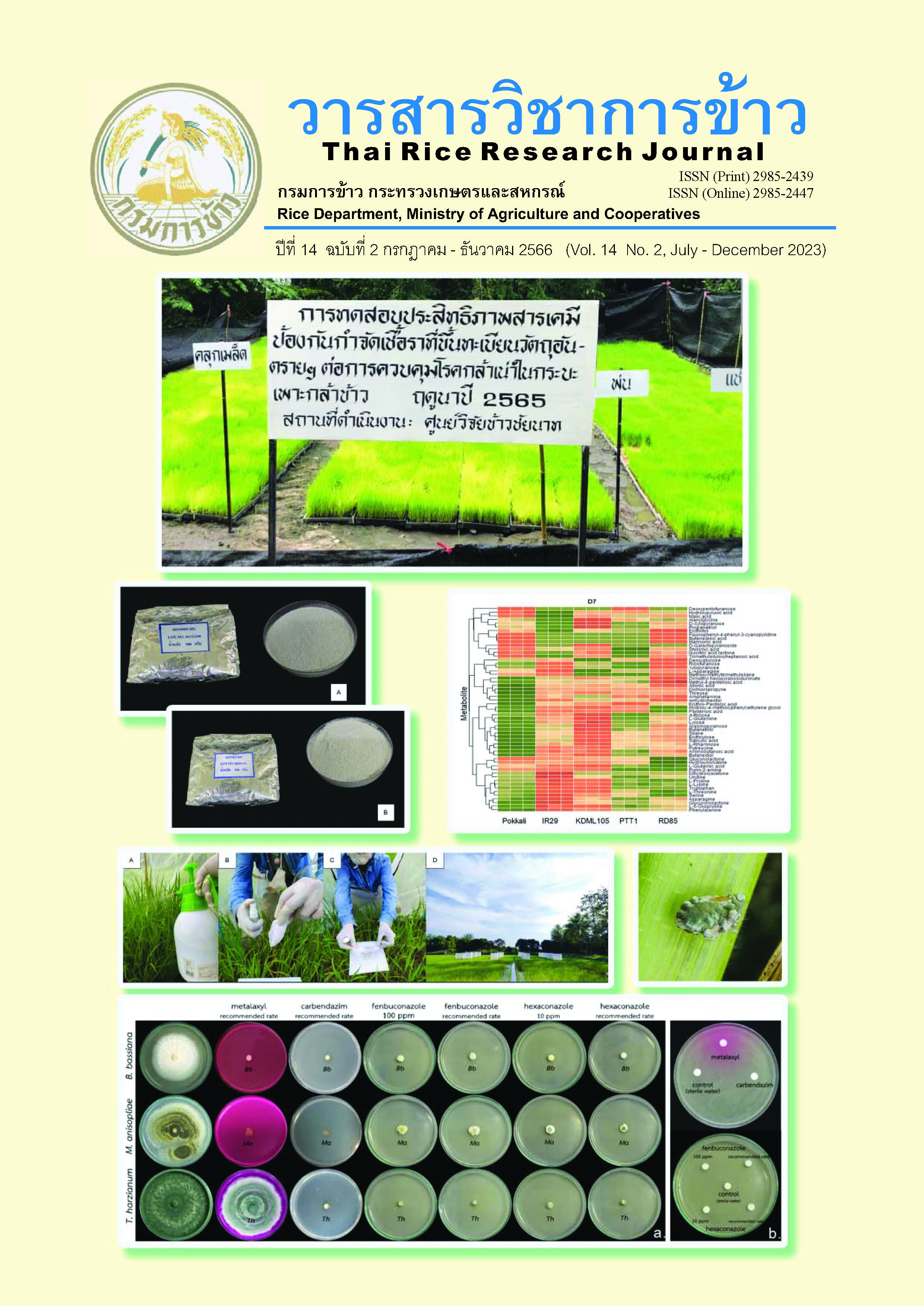การศึกษาเมแทบอลอมิกส์ความทนเค็มในพันธุ์ข้าวไทย
Main Article Content
บทคัดย่อ
เมแทบอลอมิกส์ เป็นการศึกษาการเปลี่ยนแปลงชนิดและปริมาณรวมถึงหน้าที่ของเมแทบอไลต์ระหว่างกระบวนการเจริญเติบโตหรือเมื่อพืชอยู่ภายใต้สภาวะเครียด เช่น ความเค็ม งานวิจัยนี้มีวัตถุประสงค์ที่จะนำวิทยาการเมแทบอลอมิกส์มาใช้ศึกษาการเปลี่ยนแปลงของเมแทบอไลต์ที่เกิดขึ้นในพันธุ์ข้าวไทยที่ปลูกในภาวะเค็ม โดยทำการศึกษาในข้าวพันธุ์ทนเค็ม Pokkali และพันธุ์อ่อนแอ IR29 เปรียบเทียบกับพันธุ์ข้าวไทยพันธุ์ขาวดอกมะลิ 105 ปทุมธานี 1 และ กข85 โดยการปลูกข้าวในภาวะที่มีความเค็มสูงเป็นเวลา 0 1 2 3 4 และ 7 วัน วิเคราะห์ชนิดและปริมาณของเมแทบอไลต์โดยใช้เครื่องแก๊สโครมาโทรกราฟีที่เชื่อมต่อกับแมสสเปคโตรเมทรีแบบไทม์ออฟไฟลท์ พบการเปลี่ยนแปลงของเมแทบอไลต์ในกลุ่มกรดแอมิโน น้ำตาล กรดอินทรีย์ แอลกอฮอล์ กรดไขมัน และสารอื่นๆ เช่น สารประกอบอินทรีย์ สารกลุ่มเอมีน เป็นต้น วิเคราะห์องค์ประกอบหลัก พบว่า สามารถแยกความแตกต่างของเมแทบอไลต์ของข้าวพันธุ์ทนเค็มและพันธุ์อ่อนแอได้อย่างชัดเจนตลอดการทดสอบ เมื่อพิจารณารายพันธุ์ พบเมแทบอไลต์ของข้าวพันธุ์ปทุมธานี 1และพันธุ์ขาวดอกมะลิ 105 มีความแตกต่างจากข้าวพันธุ์อื่นๆ ภายหลังการทดสอบเป็นเวลา 1 และ 4 วัน ตามลำดับ เช่นเดียวกับพันธุ์ Pokkali และพันธุ์ขาวดอกมะลิ 105 โดยพบการเพิ่มขึ้นของเมแทบอไลต์ proline ที่เป็นตัวชี้วัดสภาวะเครียดจากความเค็มของพืชและเกี่ยวข้องกับความทนทานต่อแรงดันออสโมติก นอกจากนี้ยังพบ hydroxynorvaline ซึ่งเกี่ยวข้องกับการตอบสนองต่อสภาวะเครียดในข้าวพันธุ์ทนเค็ม โดยข้าวส่วนใหญ่มีความสามารถในการทนเค็มได้มากกว่า 7 วัน ในขณะที่ข้าวพันธุ์ IR29 มีความสามารถในการทนเค็มได้เพียง 4 วัน หลังจากนั้นจะเริ่มแสดงอาการขาดน้ำและใบเปลี่ยนเป็นสีน้ำตาล และพบว่าความทนเค็มมีความเกี่ยวข้องกับกลไกที่สำคัญ ได้แก่ aminoacyl-tRNA biosynthesis, phenylalanine, tyrosine and tryptophan biosynthesis และ alanine, aspartate and glutamate metabolism จากผลการศึกษานี้นำไปสู่การศึกษาเกี่ยวกับหน้าที่และการทำงานของยีนที่เกี่ยวข้องกับการสังเคราะห์เมแทบอไลต์เหล่านี้ต่อไป
Article Details
เอกสารอ้างอิง
กิตติพัฒน์ จุลพงษ์, ภานุวัฒน์ เอ็งวงษ์ตระกูล, เสาวนิตย์ เนตรจินดา, มานิกา แย้มสุข, พรพรรณ เซี่ยงฉิน, ชุติมา พลูทอง, ทิวา พาโคกทม และคัทลียา ฉัตร์เที่ยง. 2558. ผลของความเค็มต่อการงอกและลักษณะทางสรีรวิทยา บางประการของข้าวนาสวนและข้าวก่ำ. หน้า 1805-1814. ใน: การประชุมวิชาการระดับชาติ มหาวิทยาลัยเกษตรศาสตร์ วิทยาเขตกำแพงแสน ครั้งที่ 12: ตามรอยพระยุคลบาท. 8-9 ธันวาคม 2558. มหาวิทยาลัยเกษตรศาสตร์ วิทยาเขตกำแพงแสน, จ.นครปฐม.
ธีระรัตน์ อุบลรัตน์, เกศราภรณ์ จันทร์ประเสริฐ และวาสินี พงษ์ประยูร. 2560. การตอบสนองด้านสรีรวิทยาและจัดกลุ่มข้าวหอมพันธุ์ไทย 4 พันธุ์ต่อภาวะเครียดจากความเค็มจากเกลือโซเดียมคลอไรด์. วารสารวิทยาศาสตร์บูรพา 22(2): 233-247.
Chang, J., B.E. Cheong, S. Natera and U. Roessner. 2019. Morphological and metabolic responses to salt stress of rice (Oryza sativa L.) cultivars which differ in salinity tolerance. Plant Physiology and Biochemistry 144: 427-435.
Chunthaburee, S., A. Dongsansuk, J. Sanitchon, W. Pattanagul and P. Theerakulpisut. 2016. Physiological and biochemical parameters for evaluation and clustering of rice cultivars differing in salt tolerance at seedling stage. Saudi Journal of Biological Science 23: 467-477.
Fu, L., Q. Shen, L. Kuang, J. Yu, D. Wu and G. Zhang. 2018. Metabolite profiling and gene expression of Na/K transporter analyses reveal mechanisms of the difference in salt tolerance between barley and rice. Plant Physiology and Biochemistry 130: 248-257.
Gupta, P. and B. De. 2017. Metabolomics analysis of rice responses to salinity stress revealed elevation of serotonin, and gentisic acid levels in leaves of tolerant varieties. Plant Signaling & Behavior 12(7): e1335845.
Hakim, M.A., A.S. Juraimi, M.M. Hanafi, M.R. Ismail, A. Selamat, M.Y. Rafii and M.A. Latif. 2014. Biochemical and anatomical changes and yield reduction in rice (Oryza sativa L.) under varied salinity regimes. BioMed Research International 2014(6): 208584.
Hoang, T.M.L., T.N. Tran, T.K.T. Nguyen, B. Williams and P. Wurm. 2016. Improvement of salinity stress tolerance in rice: challenges and opportunities. Agronomy 6(4): 54.
IRRI. 2002. Standard Evaluation System for Rice (SES). International Rice Research Institute, Manila. 56 p.
Jacobs, A., C. Lunde, A. Bacic., M. Tester and U. Roessner. 2007. The impact of constitutive heterologous expression of a moss Na+ transporter on the metabolomes of rice and barley. Metabolomics 3(3): 307-317.
Jumpa, T., D.M. Beckles, P. Songsri, K. Pattanagul and W. Pattanagul. 2022. Physiological and metabolic responses of Gac leaf (Momordica cochinchinensis (Lour.) Spreng.) to salinity stress. Plants 11: 2447.
Jumpa, T., J. Phetcharaburanin, M. Suksawat and W. Pattanagul. 2023. Physiological traits and metabolic profiles of contrasting rice cultivars under mild salinity stress during the seedling stage. Notulae Botanicae Horti Agrobotanici Cluj- Napoca. 51(2): 13211.
Kanawapee N, J. Sanitchon, W. Lontom, P. Threerakulpisut. 2012. Evaluation of salt tolerance at the seedling stage in rice genotypes by growth performance, ion accumulation, proline and chlorophyll content. Plant and Soil 358: 235-249.
Kazemi, K. and H. Eskadari. 2011. Effect of salt stress on germination and seedling growth of rice (Oryza sativa) cultivars in Iran. African Journal of Biotechnology 10(77): 17789-17792.
Khan, N., S. Ali and P. Zandi. 2020. Role of sugars, amino acids and organic acids in improving plant abiotic stress tolerance. Plant Metabolites and Abiotic Stress Tolerance 52(2): 355-363.
Lutts, S., J.M. Kinet and J. Bouharmont. 1995. Change in plant responses to NaCl during development of rice (Oryza sativa L.) varieties differing in salinity resistance. Journal of Experimental Botany 46(12): 1843-1852.
Lutts, S., J.M. Kinet and J. Bouharmont. 1996. Effect of salt stress on growth, mineral nutrition and proline accumulation in relation to osmotic adjustment in rice (Oryza sativa L.) cultivars differing in salinity resistance. Plant Growth Regulation 19(3): 207-218.
Lutts, S., V. Majerus and J.M. Kinet. 1999. NaCl effects on proline metabolism in rice (Oryza sativa L.) seedlings. Physiologia Plantarum 105(3): 1399-3054.
Maas, E.V. and G.J. Hoffman. 1986. Crop salt tolerancecurrent assessment. Journal of Irrigation and Drainage Division 103: 115-134.
Maeda, H. and N. Dudareva. 2012. The shikimate pathway and aromatic amino acid biosynthesis in plants. Annual Review of Plant Biology 63: 73-105.
Meloni, D.A., M.A. Oliva, H.A. Ruiz and C.A. Martinez. 2001. Contribution of proline and inorganic solutes to osmotic adjustment in cotton under salt stress. Journal of Plant Nutrition 24(3): 599-612.
Moradi, F. and A.M. Ismail. 2007. Responses of photosynthesis, chlorophyll fluorescence and ROS-scavenging systems to salt stress during seedling and reproductive stages in rice. Annals of Botany 99(6): 1161-1173.
Nguyen, H.T., R.C. Babu and A. Blum. 1997. Breeding for drought resistance in rice: Physiology and molecular genetics considerations. Crop Science 37: 1426-1443.
Pongprayoon, W., S. Chu-um, A. Pichakum and C. Kirdmanee. 2008. Proline profiles in aromatic cultivars photoautotrophically grown in responses to salt stress. International Journal of Botany 4(3): 276-282.
Rajkumari N., S. Chowrasia, J. Nishad, S.A. Ganie and T.K. Mondal. 2023. Metabolomics-mediated elucidation of rice responses to salt stress. Planta 258(6): 111.
Smimoff, N. and Q.J. Cumbes. 1989. Hydroxyl radical scavenging activity of compatible solutes. Phytochemistry 28(4): 1057-1060.
Wang, Y., X. Zeng, X. Qijun, X. Mei, H. Yuan, J. Dunzhu, Z. Sang and T. Nyima. 2019. Metabolite profiling in two contrasting Tibetan hulless barley cultivars revealed the core salt-responsive metabolome and key salt-tolerance biomarkers. AoB Plants 11(2): plz021.
Xie, Z., C. Wang, S. Zhu, W. Wang, J. Zhu and X. Zhou. 2020. Characterizing the metabolites related to rice salt tolerance with introgression lines exhibiting contrasting performances in response to saline conditions. Plant Growth Regulation 92:157-167.
Yoshida, S., D.A. Forno, J.H. Cock and K.A. Gomez. 1976. Laboratory manual for physiological studiesof rice. 3rd ed. IRRI. Los Baños, Laguna. 83 p.

